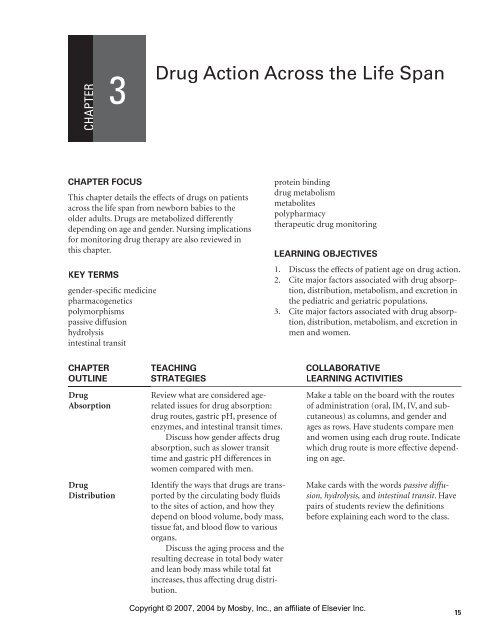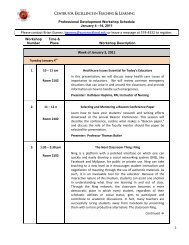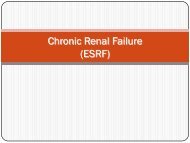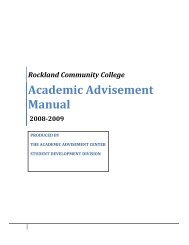Drug Action Across the Life Span
Drug Action Across the Life Span
Drug Action Across the Life Span
Create successful ePaper yourself
Turn your PDF publications into a flip-book with our unique Google optimized e-Paper software.
CHAPTER<br />
3<br />
<strong>Drug</strong> <strong>Action</strong> <strong>Across</strong> <strong>the</strong> <strong>Life</strong> <strong>Span</strong><br />
CHAPTER FOCUS<br />
This chapter details <strong>the</strong> effects of drugs on patients<br />
across <strong>the</strong> life span from newborn babies to <strong>the</strong><br />
older adults. <strong>Drug</strong>s are metabolized differently<br />
depending on age and gender. Nursing implications<br />
for monitoring drug <strong>the</strong>rapy are also reviewed in<br />
this chapter.<br />
KEY TERMS<br />
gender-specific medicine<br />
pharmacogenetics<br />
polymorphisms<br />
passive diffusion<br />
hydrolysis<br />
intestinal transit<br />
protein binding<br />
drug metabolism<br />
metabolites<br />
polypharmacy<br />
<strong>the</strong>rapeutic drug monitoring<br />
LEARNING OBJECTIVES<br />
1. Discuss <strong>the</strong> effects of patient age on drug action.<br />
2. Cite major factors associated with drug absorption,<br />
distribution, metabolism, and excretion in<br />
<strong>the</strong> pediatric and geriatric populations.<br />
3. Cite major factors associated with drug absorption,<br />
distribution, metabolism, and excretion in<br />
men and women.<br />
CHAPTER<br />
OUTLINE<br />
<strong>Drug</strong><br />
Absorption<br />
<strong>Drug</strong><br />
Distribution<br />
TEACHING<br />
STRATEGIES<br />
Review what are considered agerelated<br />
issues for drug absorption:<br />
drug routes, gastric pH, presence of<br />
enzymes, and intestinal transit times.<br />
Discuss how gender affects drug<br />
absorption, such as slower transit<br />
time and gastric pH differences in<br />
women compared with men.<br />
Identify <strong>the</strong> ways that drugs are transported<br />
by <strong>the</strong> circulating body fluids<br />
to <strong>the</strong> sites of action, and how <strong>the</strong>y<br />
depend on blood volume, body mass,<br />
tissue fat, and blood flow to various<br />
organs.<br />
Discuss <strong>the</strong> aging process and <strong>the</strong><br />
resulting decrease in total body water<br />
and lean body mass while total fat<br />
increases, thus affecting drug distribution.<br />
COLLABORATIVE<br />
LEARNING ACTIVITIES<br />
Make a table on <strong>the</strong> board with <strong>the</strong> routes<br />
of administration (oral, IM, IV, and subcutaneous)<br />
as columns, and gender and<br />
ages as rows. Have students compare men<br />
and women using each drug route. Indicate<br />
which drug route is more effective depending<br />
on age.<br />
Make cards with <strong>the</strong> words passive diffusion,<br />
hydrolysis, and intestinal transit. Have<br />
pairs of students review <strong>the</strong> definitions<br />
before explaining each word to <strong>the</strong> class.<br />
Copyright © 2007, 2004 by Mosby, Inc., an affiliate of Elsevier Inc.<br />
15
16 Chapter 3 <strong>Drug</strong> <strong>Action</strong> <strong>Across</strong> <strong>the</strong> <strong>Life</strong> <strong>Span</strong><br />
<strong>Drug</strong><br />
Metabolism<br />
<strong>Drug</strong> Excretion<br />
Nursing<br />
Implications<br />
when<br />
Monitoring<br />
<strong>Drug</strong> Therapy<br />
Review <strong>the</strong> hepatic system and its<br />
role in inactivating medications; thus,<br />
drug metabolism occurs via enzyme<br />
action in <strong>the</strong> liver.<br />
Identify those factors that affect<br />
liver function, including <strong>the</strong> presence<br />
of liver disease and heart failure.<br />
Review <strong>the</strong> renal system and how <strong>the</strong><br />
renal tubules eventually excrete drugs<br />
from <strong>the</strong> body.<br />
Discuss <strong>the</strong> alternative routes of<br />
excretion, including <strong>the</strong> GI system.<br />
Review how monitoring of drug<br />
concentrations is done by drawing<br />
blood levels 30 minutes before <strong>the</strong><br />
next dose of medication to see <strong>the</strong><br />
lowest blood level (called a trough),<br />
and <strong>the</strong>n 20 minutes after <strong>the</strong> next<br />
dose is given to get <strong>the</strong> highest blood<br />
level (called a peak).<br />
Discuss <strong>the</strong> different ways to administer<br />
drugs to children.<br />
Review growth and development<br />
to assist in understanding <strong>the</strong><br />
difference between use of liquids for<br />
infants and how older children can<br />
take chewable drugs.<br />
Identify <strong>the</strong> need to do a thorough<br />
drug history for older adult patients<br />
and review multidrug regimens.<br />
Divide <strong>the</strong> class in half, with one side<br />
representing <strong>the</strong> renal system and <strong>the</strong> o<strong>the</strong>r<br />
representing <strong>the</strong> hepatic system. Give each<br />
group cards with drug names. By exchanging<br />
cards, have students determine which<br />
drugs are metabolized primarily by <strong>the</strong>ir<br />
organ system. After <strong>the</strong> exchange, review<br />
<strong>the</strong> results of <strong>the</strong> exercise with <strong>the</strong> class.<br />
Assign one student to be a patient and<br />
ano<strong>the</strong>r to be <strong>the</strong> nurse. Role play what a<br />
nurse would explain to <strong>the</strong> patient about a<br />
peak and trough drug level needing to be<br />
drawn for gentamicin. Have <strong>the</strong> class assist<br />
with <strong>the</strong> explanation if needed.<br />
List on <strong>the</strong> board <strong>the</strong> following: infants,<br />
toddlers, preschool children. Have Post-Its<br />
available with names of drugs that are liquid,<br />
chewable, powders, and tablets. Have<br />
students come up and place <strong>the</strong> Post-Its<br />
under <strong>the</strong> appropriate headings for each<br />
drug. Review <strong>the</strong> exercise with <strong>the</strong> class.<br />
WEB RESEARCH ACTIVITY<br />
Have students search for information online about<br />
drugs and breastfeeding. Compare this information<br />
with what is covered in <strong>the</strong> text, and have <strong>the</strong>m write<br />
down <strong>the</strong>ir observations, with citations of <strong>the</strong> web<br />
pages that were visited.<br />
CASE STUDIES<br />
1. Several patients are assigned to one nurse. Their<br />
ages are 46 years, 75 years, and 92 years. Which<br />
patient is <strong>the</strong> most likely to respond readily to<br />
drug administration? Which patient is <strong>the</strong> most<br />
likely to have a drug interaction? Explain why<br />
this occurs.<br />
2. A newborn baby, 7 days old, is admitted to <strong>the</strong><br />
hospital with refractory vomiting and a diagnosis<br />
of pyloric stenosis. The physician has ordered<br />
IV fluids to keep <strong>the</strong> baby hydrated. What nursing<br />
considerations are important to remember<br />
when dealing with newborn babies? Discuss<br />
your findings in class.<br />
Copyright © 2007, 2004 by Mosby, Inc., an affiliate of Elsevier Inc.
CHAPTER<br />
3<br />
Student Name ________________________________________________________<br />
Date ___________________________ ID # ______________________________<br />
<strong>Drug</strong> <strong>Action</strong> <strong>Across</strong> <strong>the</strong> <strong>Life</strong> <strong>Span</strong><br />
Quiz<br />
MULTIPLE CHOICE<br />
_____ 1.<br />
_____ 2.<br />
_____ 3.<br />
_____ 4.<br />
Gender-specific medicine studies <strong>the</strong> differences<br />
in <strong>the</strong> normal function of men<br />
and women and how each sex differs in<br />
<strong>the</strong>ir experience of ____________.<br />
1. life<br />
2. disease<br />
3. symptoms<br />
4. healthcare<br />
What factors influence drug absorption<br />
from <strong>the</strong> gastrointestinal tract?<br />
1. pH and renal function<br />
2. passive diffusion, renal function, and<br />
muscle mass<br />
3. gastric transit time, pH, and passive<br />
diffusion<br />
4. renal function, pH, and gastric transit<br />
time<br />
In infants, which of <strong>the</strong> following factors<br />
influence <strong>the</strong> ability of a drug to be<br />
absorbed and distributed in <strong>the</strong> body?<br />
(Select all that apply.)<br />
1. presence of necessary enzymes<br />
2. thickness of <strong>the</strong> dermal layer of <strong>the</strong><br />
skin<br />
3. percent of total body fluid present<br />
and adipose tissue<br />
4. total amount of muscle mass and<br />
fluid ingested daily<br />
In older adults, <strong>the</strong> best indicator of renal<br />
function is:<br />
1. urine output.<br />
2. BUN (blood urea nitrogen) test.<br />
3. creatinine clearance test.<br />
4. urinalysis.<br />
_____ 5.<br />
_____ 6.<br />
_____ 7.<br />
_____ 8.<br />
When an older adult patient is taking<br />
multiple drugs at <strong>the</strong> same time, it increases<br />
<strong>the</strong> chance of drug:<br />
1. absorption.<br />
2. excretion.<br />
3. interaction.<br />
4. distribution.<br />
“Peak” and “trough” levels are drawn:<br />
1. to identify <strong>the</strong> development of drug<br />
tolerance.<br />
2. to determine <strong>the</strong> degree of <strong>the</strong>rapeutic<br />
response to prescribed medication.<br />
3. 20 minutes after <strong>the</strong> drug administration<br />
and 30 minutes before next<br />
dose.<br />
4. 30 minutes after drug administration<br />
and 20 minutes before next dose.<br />
Pediatric drug dosages may be based on<br />
estimated body surface area (BSA) because:<br />
1. infants’ percentage of body fluids is<br />
less than that of adults.<br />
2. <strong>the</strong>rapeutic drug monitoring is based<br />
on BSA.<br />
3. BSA is a substitute for <strong>the</strong>rapeutic<br />
monitoring.<br />
4. weight changes and growth of <strong>the</strong><br />
individual are accurately reflected in<br />
BSA.<br />
The least accurate measuring device for<br />
oral forms of liquid medication is a(n):<br />
1. oral syringe.<br />
2. dropper.<br />
3. medicine cup.<br />
4. household teaspoon.<br />
Copyright © 2007, 2004 by Mosby, Inc., an affiliate of Elsevier Inc.<br />
17
Student Name ________________________________________________________<br />
Date ___________________________ ID # ______________________________<br />
_____ 9.<br />
When “off-label use” of medications is<br />
prescribed, <strong>the</strong> nurse should:<br />
1. refuse to administer <strong>the</strong> medication.<br />
2. cross-check dosage in references or<br />
with <strong>the</strong> pharmacist.<br />
3. administer <strong>the</strong> prescribed medication.<br />
4. consult <strong>the</strong> prescribing physician before<br />
administering <strong>the</strong> medication.<br />
_____ 10. During initiation of a newly prescribed<br />
medication for a geriatric patient, it is<br />
recommended that:<br />
1. normal adult doses be used.<br />
2. 1/3 to 1/2 of <strong>the</strong> normal adult dose<br />
be administered.<br />
3. multiple new medications be initiated<br />
simultaneously.<br />
4. new medications have <strong>the</strong>rapeutic<br />
drug levels performed.<br />
_____ 11. <strong>Drug</strong>s in which classification are known<br />
to be potentially teratogenic?<br />
1. anti-inflammatory medications (e.g.,<br />
aspirin, ibuprofen)<br />
2. HMG-CoA reductase inhibitors and<br />
angiotensin-converting enzyme inhibitors<br />
3. antibiotics<br />
4. xanthine derivatives and anticholinergic<br />
bronchodilating agents<br />
COMPLETION<br />
Complete <strong>the</strong> following statements.<br />
12. CYP3S4 is <strong>the</strong> component of <strong>the</strong> cytochrome<br />
P-450 system of enzymes necessary for <strong>the</strong><br />
_____________________ of drugs.<br />
13. The placement of a transdermal drug system on<br />
<strong>the</strong> lower extremities of an older patient may result<br />
in _____________________ drug absorption.<br />
14. In passive diffusion, <strong>the</strong> drug moves from an<br />
area of _____________________ concentration<br />
to an area of _____________________ concentration.<br />
15. With active transport, <strong>the</strong> movement is from an<br />
area of _____________________ concentration<br />
to an area of _____________________ concentration.<br />
18<br />
Copyright © 2007, 2004 by Mosby, Inc., an affiliate of Elsevier Inc.
















